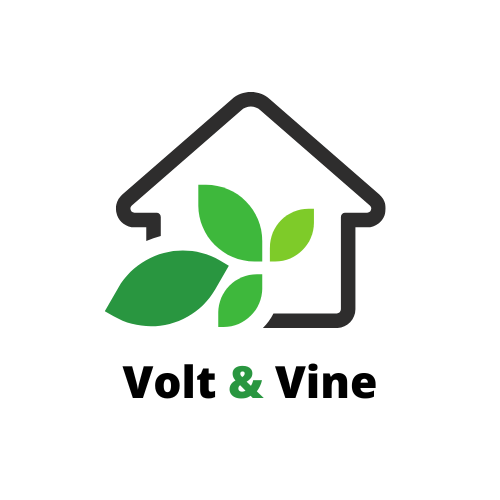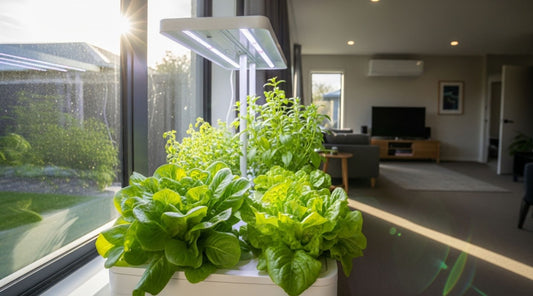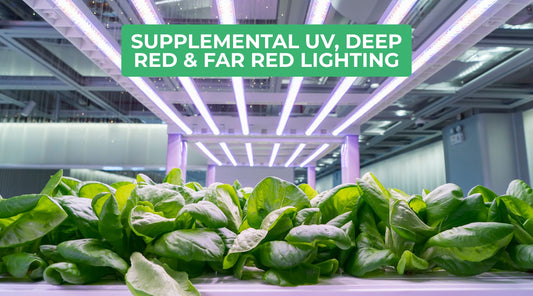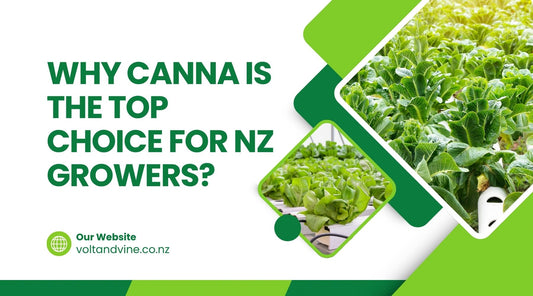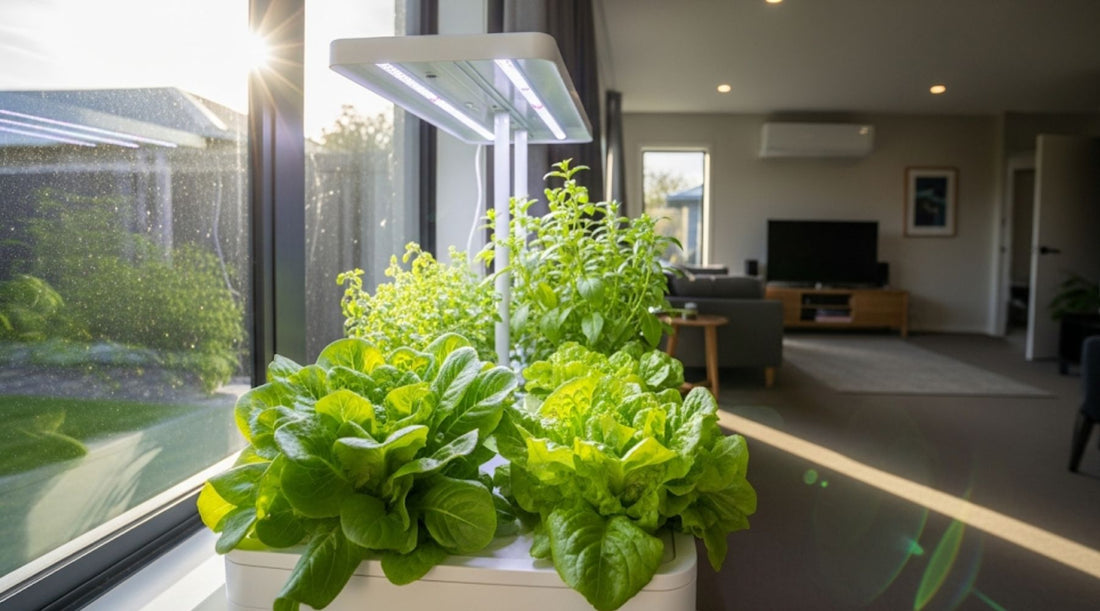
The science of hydroponic systems: a beginner's guide
Share
Did you know that NASA has been experimenting with hydroponics for decades as a way to grow food in space?
If this technology is robust enough for extraterrestrial farming, imagine what it can do in your home or for modern agriculture! It’s not magic, it’s a powerful fusion of science and engineering.
Welcome to the ultimate guide on the science of hydroponic systems! So many guides just skim the surface, showing you how but never explaining the why.
This is different. I'm going to take you deep into the core principles that make these systems tick.
We'll explore the plant biology, the fluid dynamics, the water chemistry, and the environmental engineering that transforms a simple seed into a thriving plant, all without a speck of soil.
Forget what you think you know; prepare to think like a biologist and an engineer to truly master soilless cultivation.
The biological blueprint: how plants thrive without soil
 Ever been told you need good soil to grow good plants? It’s one of the first things we learn about gardening, but what if it’s not the whole story?
Ever been told you need good soil to grow good plants? It’s one of the first things we learn about gardening, but what if it’s not the whole story?
The truth is, plants don't actually eat soil. Soil is just the middleman - a holder of nutrients, water, and oxygen. The real magic happens at a microscopic level, and understanding this is the first step to mastering hydroponics.
How roots absorb nutrients
Think of a plant's root system like a complex network of tiny straws. In a hydroponic setup, these roots are bathed in a nutrient-rich solution.
Through a process called osmosis, the roots draw in the exact mineral elements they need directly, without having to search for them in the dirt.
This direct access is a core reason hydroponic growth can be so much faster.
The importance of oxygen
We can’t live without breathing, and neither can a plant's roots.
Submerged roots need a constant supply of dissolved oxygen to survive and power nutrient uptake. Without it, they essentially drown, leading to the dreaded root rot. This is why techniques like using air stones in the water are so crucial for a healthy hydroponic system.
Ultimately, hydroponics works by skipping the soil and delivering a perfectly balanced meal of water, nutrients, and oxygen directly to the roots. As researchers at Oregon State University note, this controlled approach is the system's primary advantage.
Core engineering principles of hydroponic design
 Have you ever wondered what a high-tech hydroponic farm has in common with the plumbing in your house or a simple garden irrigation system?
Have you ever wondered what a high-tech hydroponic farm has in common with the plumbing in your house or a simple garden irrigation system?
Both are built on core engineering principles designed to move water efficiently. A good hydroponic setup is simply a life support system for plants, engineered for perfect performance.
Fluid dynamics 101
This sounds complex, but it’s just about how water moves.
In hydroponics, you’re either using a pump to actively push the nutrient solution around (active system) or using a clever trick like gravity or capillary action to deliver it (passive system).
The goal is the same: ensure every plant gets a consistent supply without waterlogging the roots.
The brain of the system
The best hydroponic designs use automation to take the guesswork out of growing. Simple timers are a great start, turning pumps or lights on and off on a set schedule.
It’s like setting a slow cooker - you put the work in upfront to create a system that runs itself, giving your plants exactly what they need, when they need it.
By understanding these basic engineering concepts, you can move from just following instructions to designing a system that’s perfectly suited to your space and plants.
Deconstructing the 6 primary hydroponic systems
 Walking into a hydroponics store in Auckland can feel overwhelming with all the different systems on display.
Walking into a hydroponics store in Auckland can feel overwhelming with all the different systems on display.
But once you know the basic engineering, you’ll see they are all just different ways of solving the same problem.
Deep water culture (DWC)
This is the perfect system for beginners and anyone wanting to grow leafy greens like lettuce and herbs.
The concept is simple: plant roots are suspended directly in a reservoir of highly oxygenated nutrient solution. An air pump with an air stone (like you'd see in a fish tank) bubbles away, providing the roots with the constant oxygen supply they need to thrive.
Nutrient film technique (NFT)
Often used in commercial setups, NFT systems are incredibly water-efficient.
Plants sit in a shallow, sloped channel, and a thin film of nutrient solution constantly flows over the tips of the roots.
This provides everything the plant needs without completely submerging the root system, allowing for excellent oxygen exposure. According to a study in the journal Agronomy, this method is highly effective for increasing the yield of crops like lettuce.
Ebb and flow (flood and drain)
This system is a fantastic all-rounder. Plants sit in a tray filled with a growing medium like clay pellets or perlite.
On a timer, a pump floods the tray with nutrient solution, submerging the roots. Then, after a set period, the pump switches off and the water drains back into the reservoir.
As Oregon State University's guide explains, this "ebb and flow" action is excellent for pulling fresh oxygen into the root zone during the drain cycle, promoting vigorous, healthy growth.
Drip systems
Common in commercial greenhouses and great for larger plants, drip systems are a model of efficiency.
A main pump line branches off into smaller tubes that lead to each individual plant. An emitter at the end of each tube delivers a slow, controlled drip of nutrient solution directly to the base of the plant.
This method minimises evaporation and ensures a very precise, consistent feeding schedule, which is why it's a cornerstone of modern, efficient farming.
Wick systems
This is hydroponics at its most simple and is a perfect science experiment for the kids. A wick, often made of rope or felt, connects the growing medium to the nutrient reservoir below.
Through simple capillary action - the same process that pulls water up a paper towel - the wick passively draws the nutrient solution up to the roots.
It has no moving parts and requires no electricity, making it ideal for small, non-fruiting plants like herbs and lettuce.
Aeroponics
If hydroponics is futuristic, aeroponics is straight out of a sci-fi movie. Plant roots hang suspended in the air within a dark chamber and are periodically sprayed with a fine, nutrient-rich mist.
This method provides unparalleled access to oxygen. It’s so efficient, in fact, that NASA has researched it extensively for growing food in space, as it uses minimal water and allows for rapid growth in a controlled, lightweight system.
From the simplicity of DWC to the efficiency of NFT, there is a system for every goal. Next, we'll dive into the chemistry that fuels them all...
The chemical kitchen: mastering nutrient solution science
 If growing plants is like cooking, then the nutrient solution is your pantry of ingredients. A pinch of this, a dash of that - it’s a recipe for success.
If growing plants is like cooking, then the nutrient solution is your pantry of ingredients. A pinch of this, a dash of that - it’s a recipe for success.
But unlike cooking a meal, you can’t just eyeball it. In the precise science of hydroponics, becoming a master "chef" means understanding the fundamental chemistry that fuels plant growth.
The Big Three Metrics
To manage your nutrient solution effectively, you need to track three key things. Think of them as the temperature, cooking time, and ingredient list for your plant's meal.
Nutrients (The Ingredients)
Plants need a balanced diet of macronutrients like Nitrogen (N), Phosphorus (P), and Potassium (K), plus a range of micronutrients. Pre-mixed hydroponic fertilisers make this part easy.
pH (The Unlocking Key)
This measures the acidity of your solution. If the pH is wrong (typically outside the 5.5-6.5 range), it "locks" the nutrients, making them unavailable to your plants even if they're in the water.
EC (The Strength)
Electrical Conductivity measures the total amount of nutrients in your solution. It’s like checking how strong you’ve mixed your cordial - too weak and the plant starves; too strong and you can burn the roots.
Getting this mix right is the most critical part of hydroponics. As the University of Florida notes, "maintaining the nutrient solution is a continuous process of monitoring and adjustment" to ensure the plants get exactly what they need.
Engineering the ideal growing environment
Think a plant is happy as long as its roots are fed? Think again. The air and light surrounding your plants are just as important as the water below.
To get truly impressive results, you need to become an environmental engineer, creating the perfect "greenhouse effect" whether you're growing in a closet or a glasshouse.
The Science of Light

Natural sunlight is great, but for indoor growing, you need to provide the right kind of light. It’s not just about brightness; it’s about the colour spectrum.
Plants use blue light for strong leafy growth and red light to promote flowering and fruiting.
Modern LED grow lights are engineered to deliver this Photosynthetically Active Radiation (PAR) for optimal plant health.
Temperature, Humidity, and Airflow
Plants "breathe" through their leaves, a process called transpiration. If the air is too hot, dry, or stagnant (like a stuffy room on a humid Auckland day), this process can slow down or stop, stressing the plant.
A simple fan to ensure good airflow and a way to manage temperature makes a massive difference in plant health and nutrient uptake.
By controlling the light, temperature, and air, you are engineering a five-star resort for your plants, ensuring they are healthy, productive, and efficient.
The modern toolkit: monitoring, sensors, and data

In New Zealand, we have a "she'll be right" attitude, but that’s a recipe for disaster in hydroponics.
You can't manage what you don't measure. Moving from a beginner to a pro means swapping guesswork for data and using the right tools to get a clear picture of what’s happening in your system.
Your Must-Have Meters
The two most important tools in your kit are a digital pH meter and an EC (or TDS) meter. These are your windows into the nutrient solution, giving you precise, instant readings that allow you to make informed adjustments.
The Art of Calibration
A meter that isn't calibrated is just giving you a random number. Think of it like a kitchen scale you haven't zeroed out - every measurement will be wrong. Calibrating your meters regularly with buffer solutions ensures your data is accurate and trustworthy, a step that experts at the University of Arizona call "the most important, and often most neglected, aspect of water quality monitoring" (UA-CEAC, n.d.).
By taking a few minutes each day to measure and log your data, you can spot trends, catch problems before they start, and truly begin to understand the needs of your plants.
Troubleshooting like a pro: scientific solutions to common problems
Even with the best gear and perfect planning, you’ll eventually run into problems. It happens to every grower.
But here’s the secret: in hydroponics, problems are just puzzles. Instead of panicking, you can put on your scientist hat, look for the clues, and use your knowledge to find a rational solution.
Diagnosing Nutrient Deficiencies
When you see yellowing leaves, your plant is sending you a message. This is often the first sign of a nutrient deficiency.
Think of it as a warning light on your dashboard. Is the yellowing on old, lower leaves? That often points to a lack of a mobile nutrient like Nitrogen.
Is it on new growth? It could be an immobile nutrient like Calcium or Sulphur. Observing where the problem appears is key to diagnosing it correctly.
The Villain of Root Rot
Are your plant’s roots brown, slimy, and smelly? You’ve likely got root rot, a common issue caused by a lack of dissolved oxygen.
Pathogens like Pythium thrive in these stagnant conditions. As Penn State Extension advises, the solution isn’t just to treat the plant, but to fix the environment by increasing aeration with a larger air stone or ensuring your water temperature doesn't get too warm (Dunn, 2017).
By learning to read the signs and understanding the underlying cause, you can shift from simply reacting to problems to proactively preventing them.
The next frontier: advanced and emerging hydroponic technologies
If you think a home DWC kit is futuristic, you should see where the science of hydroponics is heading. This technology is at the heart of a global food revolution, tackling issues of land use, sustainability, and food security. The core principles are the same, but the scale and integration are something else entirely.
Vertical Farming
Why build farms outwards when you can build them upwards? Vertical farming uses hydroponic systems stacked in climate-controlled layers inside buildings.
This approach allows for massive crop production on a tiny land footprint, making it perfect for growing fresh produce right in the heart of cities like Auckland or Christchurch, drastically cutting down on food miles.
Aquaponics - The Ultimate Partnership
This is where hydroponics meets aquaculture (fish farming). In an aquaponics system, the fish provide the nutrients for the plants.
Their waste is converted by beneficial bacteria into perfect plant food. In return, the plants filter and clean the water for the fish. It’s a beautifully efficient, closed-loop system that produces both protein and vegetables.
These advanced systems show that hydroponic science isn't just a hobby; it's a critical component of a more sustainable and high-tech agricultural future.
Is Hydroponic for you?
We've journeyed from the microscopic world of the plant root right up to the cutting-edge technology of urban vertical farms.
The science of hydroponic systems isn't about memorising complicated formulas; it's about understanding the fundamental needs of a plant - water, nutrients, oxygen, and light - and using clever engineering to deliver them perfectly.
You now possess the foundational scientific knowledge that separates casual growers from true masters of soilless cultivation.
Your next step? Don't just build a system - engineer one. Start with a simple DWC or drip system, but this time, approach it with your new knowledge.
Measure your pH and EC daily. Observe how your plants respond to changes. Think about the "why" behind every component.
This is how you innovate, troubleshoot, and achieve truly spectacular results. The future of food is here, and you are now equipped to be a part of it.
References
Tirkey, A., B. S. Priyanka, V. M. Prasad, and V. Bahadur. 2023. "Performance of Lettuce (Lactuca sativa L.) Varieties under Different Hydroponic Systems". Agronomy 13, no. 1: 233. https://doi.org/10.3390/agronomy13010233
Treftz, C., & Omaye, S. T. (2016). "Hydroponics: A brief guide to soilless farming". UNR Extension, FS-16-03.
Tyson, R., R. Koenig, and D. Bodie. (2021). A practical guide for hydroponic and soilless growing. University of Florida, IFAS Extension. https://edis.ifas.ufl.edu/publication/HS1422
